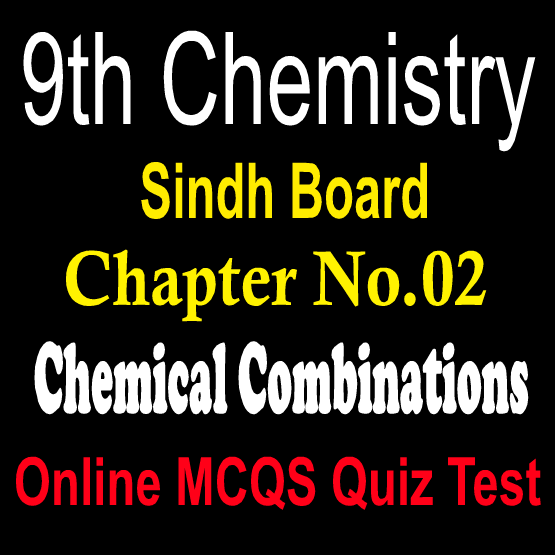9th Grade Chemistry Chapter 2 Chemical Combinations Sindh Board MCQs Notes Online Chapter Wise Question Answers. Sindh Boards Chemistry Subject Notes For Exams Preparations Karachi, Jamshoro, Sindh Boards. Chemistry class Ninth sindh board notes Unit 2 Chemical Combinations Most Repeated Multiple Choice Questions With Answers. Chemistry notes for class IX sindh board karachi Boards.
 |
| 9th Chemistry Sindh Board MCQs |
Q.1: Mass can neither be created nor destroyed during a chemical reaction, is the law of?
- reciprocal proportion
- conservation of mass
- constant composition
- multiple proportion
B
Q.2: Law of Multiple proportion was proposed by?
- Ritcher
- Lavoisier
- Louise Proust
- John Dalton
D
Q.3: Berzelius performed the experiments on the preparation of?
- ZnS
- PbS
- FeS
- H2S
B
Q.4: A combination of symbols of atoms or ions, that are held together chemically in a compound is called?
- simplest formula
- molecular formula
- empirical formula
- formula
D
Q.5: 2 moles of CaCO3 is equal to?
- 160g
- 200g
- 88g
- 100g
B
Q.6: 23 a.m.u. of Na is equal to?
- 2 moles
- 4 moles
- 3 moles
- 1 mole
D
Q.7: CaCO3 CaO + CO2 is an example of:?
- decomposition reaction
- combustion reaction
- single displacement
- addition reaction
A
Q.8: A reaction in which substances reacts with oxygen is?
- combustion reaction
- single displacement reaction
- addition reaction
- decomposition reaction
A
Q.9: Which type of reactions are neutralization and hydrolysis reaction?
- single displacement
- addition
- decomposition
- double displacement
D
Q.10: The number in front of the formula in a chemical equation is called?
- subscript
- Co efficient
- expression
- none of these
B
Q.11: Symbol represents?
- light
- state of matter
- heat
- catalyst
C
Q.12: How many grams atoms arc therein 5 moles of carbons?
- 24g
- 36g
- 60g
- 12g
C
Q.13: NA represents?
- mole
- mass number
- atomic number
- Avogadros Number
D
Q.14: A reaction in which two or more substances react to form a single substance is called?
- combustion reaction
- displacement reaction
- decomposition reaction
- addition reaction
D
Q.15: Avogadros Number shows the number of?
- electrons
- particles
- neutrons
- protons
B
Q.16: The formulas for all atoms in an empirical formula of a compound is?
- Empirical formulas
- Structural formulas
- Chemical formulas
- Molecular formulas
A
Q.17: In 1961, the standard for atomic masses was designated by the isotope of:?
- C\-12
- C-13
- H-1
- C-14
A
Q.18: One mole of any substance contains?
- Unequal number of particles
- Equal number of particles
- Avogadro numbers of particles
- Dalton numbers of particles
C
Q.19: Avogadro number is constant. Its value is:?
- 3.02 x 1021
- 3.02 x 1022
- 3.02 x 1023
- 3.02 x 1024
C
Q.20: Benzene has molecular formula C6H6. Its empirical formula will be?
- C18H18
- C2H2
- C12H12
- CH
D
Q.21: One mole of CO2 contains CO2?
- 22g
- 12g
- 32g
- 44g
D
Q.22: In water, the ratio between the masses of hydrogen and oxygen is:?
- 1:2
- 1:8
- 2:1
- 2:16
B
Q.23: The mass of one mole of substance is called:?
- Molecular mass
- Formula mass
- Molar mass
- Atomic mass
C
Q.24: In a chemical equation, reactants are written on the left hand side and products are written on the:?
- Left
- Middle
- Right
- Upper
C
Q.25: The symbol represents a?
- No way reaction
- Half way reaction
- One way reaction
- Two way reversible reaction
D






